INSTRUCTIONS
- This paper consists of TWO sections A and B
- Answer ALL questions in Section A. In section B answer QUESTION 6 and any other TWO.
- Answer all questions in English.
QUESTIONS
SECTION A
-
- What is geography (2marks)
- Give two types of environment (2marks)
- The diagram below represents the structure of the earth. Use it to answer the questions.

- Name:
- the part marked P and R (2marks)
- three features that makes up part marked Q (3marks)
- Name:
-
- Differentiate between folding and faulting (2marks)
- Name three relief features formed as a result of folding (3marks)
-
- Apart from physical weathering, give two other types of weathering (2marks)
- List four physical weathering processes that takes place in Arid areas (4marks)
-
- What is drainage pattern (2marks)
- Give three types of drainage system (3marks)
SECTION B
Answer question 6 and any other TWO questions from this section
- Study the map of Kisumu East 1:50,000 (sheet 116/2) provided and answer the questions
-
- What type of map is Kisumu East map extract? (1mark)
- Give the latitudinal and longitudinal position of the North West corner of the map (2marks)
- what is the general direction of the flow of the river Ombeyi (1marks)
- Apart from rivers identify two any other drainage features in the area covered by the map (2marks)
- Give the six figure grid reference of the trigonometrical station SKP 14 in the North Eastern part of the area covered by the map (2marks)
-
- Using a vertical scale of 1cm to represent 100 meters, draw a cross section from grid reference 960980 to grid reference 030980 (4marks)
- On the cross-section, mark and name the following
Rivers (1mark)
Dry weather road (1mark)
Steep slope (1mark) - Calculate the vertical exaggeration (VE) of the section (2marks)
-
- Citing evidence from the map, identify two social services offered in Kisumu municipality (4marks)
- Citing evidence from the map explains two factors that favour the establishment of plantation in the area covered by the map (4marks)
-
-
-
- Give two examples of non-metallic minerals (2marks)
- Describe the following characteristics of minerals
Colour (2marks)
Hardness (2marks)
Lustre (2marks)
-
- Give two forms of metamorphism (2marks)
- List three examples of metamorphism (3marks)
-
- Describe the formation of plutonic rocks (3marks)
- State two conditions necessary for the growth of coral polyps (2marks)
- You are planning to carry out a field study on study on rocks within the local environment
- Formulate three objectives of your study (3marks)
- For your field study, you have prepared a work schedule. State two items you would include in the schedule (2marks)
- Give two methods of data collection you will use while in field (2marks)
-
-
- what is lava (2marks)
- The diagram below shows some intrusive volcanic features
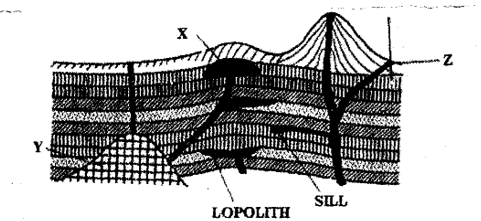
- Name the features marked X, Y and Z (3marks)
- Describe how the following features are formed Sill (4marks)
Lopolith (4marks)
- Describe the composition of composite volcano (4marks)
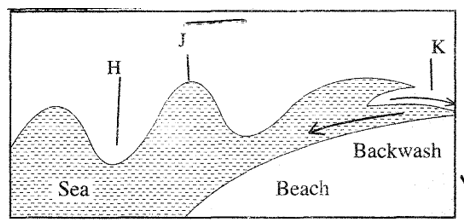
- Explain four ways in which volcanic features influence human activity (8marks)
-
-
- Define an ocean (2marks)
- State three types of seas (3marks)
-
- Give three characteristics of the continental shelf (3marks)
- Describe the following processes of wave erosion along the coast
Abrasion (2marks)
Hydraulic action (2marks)
Solution (2marks)
- The diagram below shows a breaking sea wave; use it to answer the questions below
- Name the features marked H, J, K (3marks)
- With the aid of well labeled diagrams describe the process through which a stack is formed (8marks)
-
-
- what is soil (2marks)
-
- List three components of soil (3marks)
- Explain how the following factors influence soil formation
Parent rock (4marks)
Topography (4marks)
- Draw a well labeled diagram of mature soil profile (4marks)
- Explain four ways in which human activities may lead to soil erosion (8marks)
MARKING SCHEME
-
- What is geography
It’s the descriptive study of the distribution and inter-relationship of natural and human features /phenomena on the earth surface/the study of the earth as home of mankind. (1×2=2marks) - Give two types of environment
- physical environment
- human/man made environment (2×1=2marks)
- What is geography
- The diagram below represents the structure of the earth. Use it to answer questions
-
- Name; the part labeled
P—Atmosphere
R—Moho/Mohorovicic discontinuity (2×1=2marks) - Three features that makes up part marked Q
- Rivers
- Swamps
- Oceans
- Seas
- Lakes (3×1=3marks)
- Name; the part labeled
-
-
- Differentiate between folding and faulting
Folding refers to bending of layers of crustal rocks due to compression forces while faulting refers to cracking/breaking/fracturing of layer of crustal rocks due to tensional/ compression /shear forces
1×2=2marks) - Name three relief features formed as a result of folding
- fold mountains
- synclinal valleys /depressions
- Rolling plains
- Ridges
- Intermontane basins
- Intermontane plateaus (3×1=3marks)
- Differentiate between folding and faulting
-
- A part from physical weathering, Give two other types of weathering
- Chemical weathering
- Biological weathering (2×1=2marks)
- List four physical weathering processes that takes place in Arid areas
- Exfoliation
- Granular disintegration
- Block disintegration
- Pressure release /off-loading
- Crystal growth / crystallization (4×1=4marks)
- A part from physical weathering, Give two other types of weathering
-
- what is drainage pattern
It is the plan / layout that a river and its tributaries on the landscape (1×2=2marks) - Give three types of drainage system
- Accordant
- Discordant/superimposed/antecedent
- Back tilted/Reverse drainage system (3×1=3marks)
- what is drainage pattern
SECTION B
Answer question 6 any other two from this section6Study the map of Kisumu East 1;50,000 (sheet 116/2) provided and answer the questions below
-
-
- What type of map is Kisumu East map extracted
Topographical map (1×1=1mark) - Give the latitudinal and longitudinal position of the North West corner of the map
- Latitude:0° 001
- Longitude: 34° 451 (2marks)
- What is the general direction of the flow of river Ombeyi
- South West wards / From North East to South West (2×1=2marks)
- Apart from rivers identify two other drainage features in the area covered by the map
- Seasonal swamps
- Lakes (2×1=2marks)
- What type of map is Kisumu East map extracted
- Give the six figure grid reference to the trigonometrical station SKP 14 in the North Eastern part of the area covered by the map 081980 (2marks)
-
- Using a vertical scale of 1cm to represent 100 meters, draw a cross section from grid reference 960980 to grid reference 030980 (4marks)
- On the cross section, mark and name the following:
- Rivers (1mark)
- Dry weather roads (1mark)
- Steep slope (1mark)
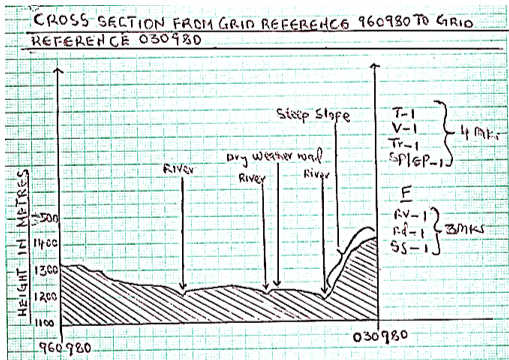
- Calculate the vertical exaggeration (VE) of the section
VE=VS/HS= 1:100m/1:50,000
=1:10000/1:50,000 = 1/10000÷1/50,00
1/10000×50,000/1
=5 times (2marks)
-
- Citing evidence from the map, identify two services offered in Kisumu municipality
Services Evidence- Education --Presence of schools
- Religious --Presence of church
- Recreation --presence of stadium
- Security/administrative --Presence of police station
- Transport --Presence of roads
- Water supply --Presence of water works
- Health/medical --Presence of hospital
- Trading /commerce --Presence of market
- Communication --Presence of post office
- Residential --Presence of build up areas /huts
- Rehabilitation -presence of a prison (2×2=4marks)
- Citing evidence from the map, explain two factors that favors the establishment of plantation in the area covered by the map
- The area receives high rainfall suitable for plantation faming as evidenced by presence of many permanent rivers
- Gentle sloping landscape suitable for mechanization is evidenced by widely spaced contours.
- Available for labour in the plantation as evidenced by presence of many /dense settlements
- Available of transport for transporting farm products to the market as evidenced by presence of many road networks (2×2=4marks)
- Citing evidence from the map, identify two services offered in Kisumu municipality
-
-
-
- Give two example of non-metallic minerals
- coal --silicon
- Nitrates --Carbon
- Graphite --Fluorspar
- Sulphur --Potash
- Petroleum -- Sodium
- Asbestos --Diamond (2×1=2marks)
- Describe the following characteristics of minerals
- Colour ----- different minerals display display different colours (2marks)
- Hardness -----different minerals have different degrees of hardness (2marks) --Lustre ----- minerals differ in their brightness depending on the nature of their reflective surface (2marks)
- Give two example of non-metallic minerals
-
- Give two forms of metamorphism
- Thermal metamorphism
- Dynamic metamorphism
- thermo-dynamic metamorphism (2×1=2marks)
- List three examples of metamorphic rocks
- Marbles
- Slate
- Quartzite
- Schist/hornblende/mica
- Serperitinite
- Gneiss (3×1=3marks)
- Give two forms of metamorphism
- Describe the formation of plutonic rocks
- Magma /molten rocks materials is intruded into the layer of crustal rocks
- Magma cools and solidifies slowly forming large crystals /coarse /grained /textured rocks (3marks)
- State three conditions necessary for the growth of coral polyps
- Warm ocean water /about 20-30º
- The water should be shallow to allow sunlight to penetrate /depth up to 60metres
- The water should be clear /free from silt /mud
- The water should be saline
- There should be plenty supply of plankton /microscopic plants food
- The water should be well oxygenated (3×1=3marks)
- Describe the formation of plutonic rocks
- You are planning to carry out a field study on rocks within the local environment
- Formulate three objectives of your study
- To find out the types of rocks in the area
- To investigate on the use of rocks
- To find out the economic value of rocks in the area
- To find out how rocks in the area were formed (3×1=3marks)
- For your field study, you have prepared a work study schedule. State two items you would include in the schedule
- Time for departure
- Time for lunch
- Time to end the study
- Time to spend in the studying (2×1=2marks)
- Give two methods of data collection you will use while in the field
- Observing
- Taking photographs /photographing
- Interviewing
- Administering questions
- Collecting samples (2×1=2marks)
- Formulate three objectives of your study
-
-
- What is lava
Is the molten rock materials that has reached the surface (2marks) - The diagram below shows some intrusive volcanic features
- Name the features marked X,Y, and Z
X—Laccolith
Y---Batholith
Z---Dyke - Describe how the following features are formed
- Sill
- Magma under high pressure enters of crustal rocks
- It is forced along the bedding plane / horizontal cracks
- It cools and solidifies slowly along the bedding plane
- This forms a sheet of igneous intrusion along the bedding plane known as the sill
- Lopolith
- Magma under high pressure enters layers of crustal rocks
- It forces itself along the bedding plane
- This forces layers of crustal rocks to upwell as their space is occupied or introduces magma
- Magma cools and solidifies slowly forming a saucer shaped mass of igeneous known as lopolith
- Name the features marked X,Y, and Z
- Describe the characteristics of a composite volcano
- It has a vertical vent/pipe
- It has alternating layers of ash/pyroclasts and lava
- Its conical in shape, steep sided
- It has side vents
- It has conelet /parasitic cone on the sides
- At the peak it may have a caldera /crater /plug (4×1=4marks)
- Explain four ways in which volcanic features influences human activity
- Volcanic mountains are source of rives which provides water for domestic, Industrial, transport and irrigation
- The windward slope of Volcano Mountain receives high relief rainfall on their windward slopes promoting agriculture
- Stream jet/hot springs can be used to generate geothermal/power for domestic/ industrial use
- Volcanic rocks provides materials for building and construction
- Volcanic features such as hot spring attract tourists earning the country foreign exchange
(4×2=8marks)
- What is lava
-
-
- Define an ocean
Is the large body of saline water occupying a huge depression between continents (2marks) - State three types of seas
- Marginal seas
- Inland seas
- Sea connected to oceans through straits (3×1=3marks)
- Define an ocean
-
- Give three characteristics of the continental shelf
- It is gently sloping
- Has a fairly smooth surface
- It is shallow, favoring growth of plankton
- Varies in width from place to place (3×1=3marks)
- Describe three processes of wave erosion along the coast
Abrasion or corrosion (2marks)
Rock fragments carried by waves are used as a tool to grind against the cliff face as the wave breaks. Rock fragments carried by the back wash erode the sea.
Attrition (2marks)
Particles that are carried by waves are constantly colliding against each other and wears into smaller size
Solution/corrosion (2marks)
The solvent and chemical action of the sea water dissolves and removes the soluble minerals that are found in the cliff or sea floor especially where there is limestone rock.
Hydraulic action (2marks)
The swash or breaking waves hit against the cliffs shattering the rocks. The breaking waves compress air into the cracks or joints in the cliff face, this widens the cracks and part of the rocks may break off
- Give three characteristics of the continental shelf
-
- The diagram below shows a breaking sea wave
Use it to answer question below - Name the features marked H, J, K
H—Tough (1mark)
J---- Crest (1mark)
K---Swash (1mark) - With the aid of well labeled diagrams describe the process through which a stack is formed (8marks)
- Waves attack both sides of a headland at right angle
- The waves erode through abrasion and hydraulic actions forming caves on both sides of the headland
- Continued wave erosion and weathering leads to the elongation of the caves into the headland. Eventually caves merges leading to formation of an arch
- The roof of the arch collapses leading to isolation of part of the headland on the seaward side. The isolated headland is the stack
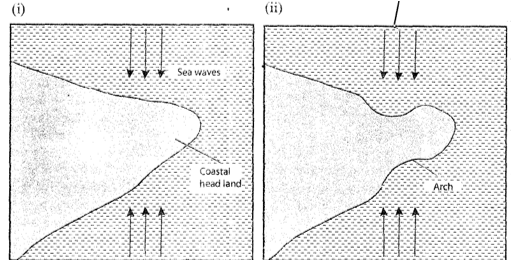
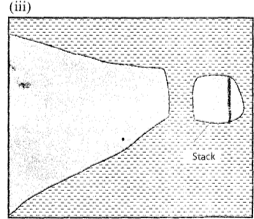
- waves attack both sides of a headland at right angle
- the waves rode through abrasion and hydraulic actions forming caves on both sides of the headland
- continued wave erosion and weathering leads to the elongation of the caves into the headland
- eventually caves merge leading to formation of an arch
- the isolated headland is the stack
- the roof of the arch collapses leadind to isolation of part of the headland on the seaward side
- The diagram below shows a breaking sea wave
-
-
- What is soil
It’s a naturally occurring thin layer of loose/ unconsolidated materials which overlies the crustal rocks/on which plants grow/ its an accumulation of rock particles (2marks) -
- List three components of soil
- Mineral particles/ inorganic matter
- Humus / organic matter
- Water
- Air
- Living organisms (3×1=3marks)
- Explain how the following factors influence soil formation
Parent rock- The nature of rock influences the rate of weathering in that soft rock weather fast /hard rocks are resistant and weather slowly
- The parent rock determines the soil texture in that large/ course grained rocks produce large /course grained soil
- The type of minerals in the parent rock are transferred to the soil during formation
Topography - It determines the rate of weathering /steep slopes encouraging high rate of weathering
- It influences soil drainage /where land is flat ,soils are poorly drained
- The slope influences the arrangement/ sequence of soil /catena
- It influences soil depth, gentle slopes have deep soil while steep slopes have thin soil (2×2=4marks)
Draw a well labeled diagram of mature soil profile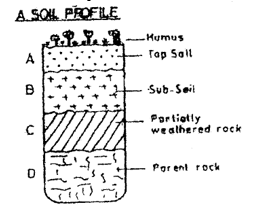
- List three components of soil
- Explain four ways in which human activities may lead to soil erosion
- Mono cultural farming activities leads to soil exhaustion thus making the soil vulnerable to erosion
- Overstocking / overgrazing reduce vegetation cover exposing soils to agents of erosion
- Ploughing up and down a slope provides channels for surface run off. This are enlarged become gullies
- Deforestation/clearing vegetation cover exposes soils to agents of erosion
- Mining/ Quarrying /road construction loosen /exposes the soil to agents of erosion
- Continuous cultivation without replenishing of soil fertility leads to soil exhaustion making the soil vulnerable to erosion
- Cultivation of crops in marginal areas may lead to loosening of soil particles especially during the dry seasons resulting in wind erosion
- Human settlement and cultivation on steep slopes / river banks increases soil erosion (4×2=8marks)
- What is soil
Download Geography Paper 1 Questions and Answers - Cekana Mock Exams 2023.
Tap Here to Download for 50/-
Get on WhatsApp for 50/-
Why download?
- ✔ To read offline at any time.
- ✔ To Print at your convenience
- ✔ Share Easily with Friends / Students
